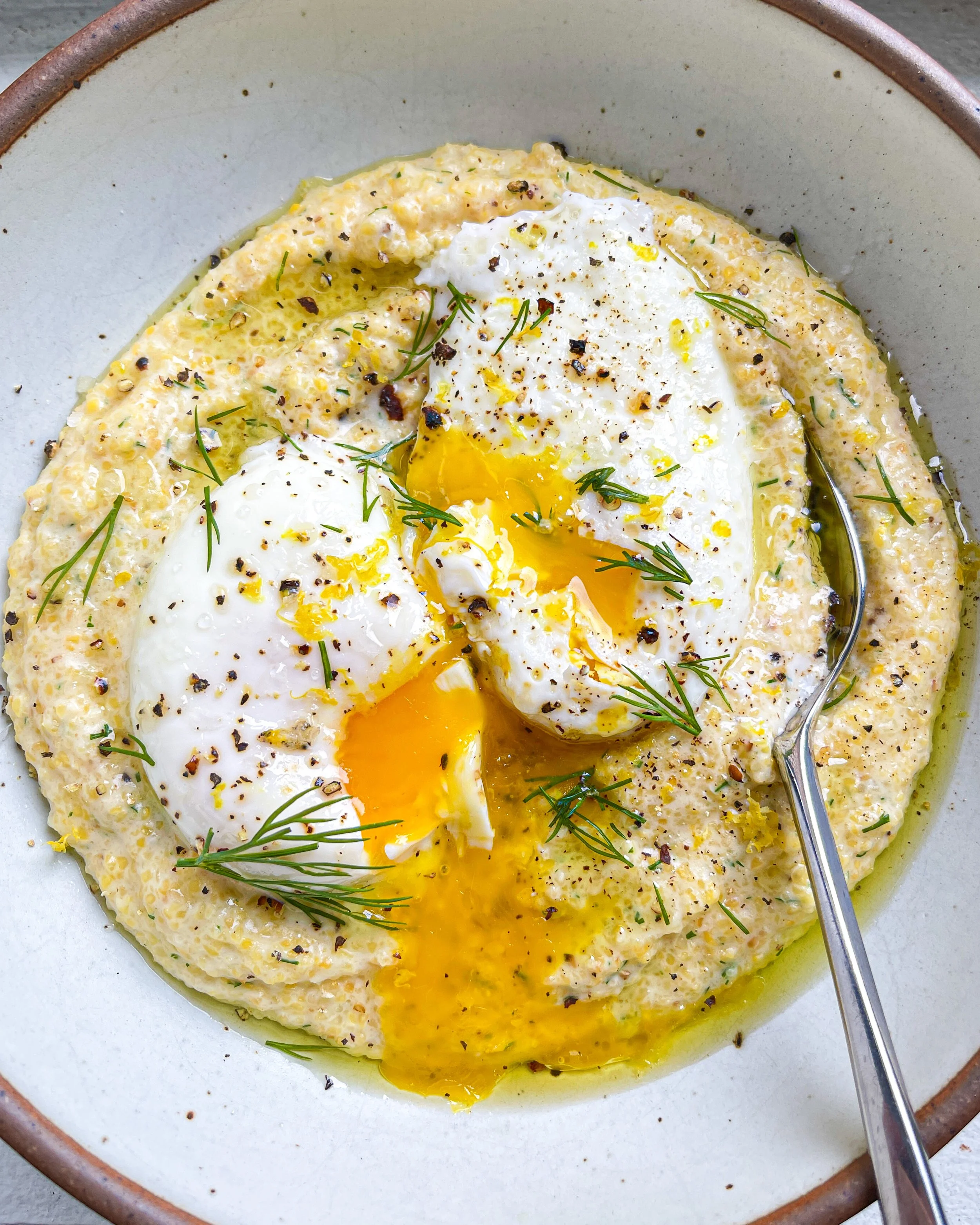Brown Butter, Lemon & Herb Polenta with Poached Eggs
There’s not a word in the English dictionary that can properly summarize the deep love I feel for polenta in general. So, let me just say: I’m obsessed with polenta.
Polenta is one of those dishes that gets a bad rap, likely because boring polenta is as common as it is excruciatingly lackluster. Good polenta — the kind that’s luxuriously creamy without being overly rich — needs a little bit of TLC to become something special, and that’s exactly what this shockingly-easy polenta recipe sets out to do.
What is polenta?
The real question here is: what isn’t polenta? To me, it’s a goes-with-anything side (or base) that you can whip up quickly and easily, and flavor exactly how you wish — add a splash of citrus juice or zest (or good balsamic vinegar) to keep things bright, or load it up with cream and your cheese-of-choice for a decadent, creamy dish. The choice is all yours. In fact, polenta’s staggering versatility is the main reason why I always keep a bag of quick-cooking polenta in my pantry.
Basically, polenta is a cornmeal-based porridge that started as a common meal among farmers in Northern Italy. You’ll be able to find polenta — either the traditional variety or quick-cooking type — at most grocery stores, usually in a box or bag. If you can’t, fear not. Regular ol’ coarse-ground cornmeal will do the trick, just go ahead and give it a quick whiz in your food processor to cut down on cooking time. You can also use regular grits, since they’re basically polenta’s cousin. Polenta and grits are essentially the same, though they’re made from two different types of corn. For that reason, grits tend to be a bit starchier than polenta, and require more frequent stirring while you cook ‘em to avoid any clumping.
How to toast polenta
I’m a strong believer in toasting most grains before you cook them for maximum flavor and nuttiness — think: quinoa, or arborio rice for risotto. Polenta is no exception, which is why I gently toast the dried polenta used in this recipe in brown butter, before adding the half & half and water. Toasting polenta this way is incredibly easy since it’ll literally start popping and crackling when it’s toasted to perfection. Take this simple step, and you’ll be rewarded with polenta that is fragrant and nutty, with incredible depth of flavor.
Gently toasting polenta in brown butter brings out its nuttiness, which contrasts beautifully with the sharp bite of lemon.
What to serve with polenta
A perfectly-runny poached egg is always my topping of choice when it comes to a creamy batch of polenta, but you should feel free to top this dish with whatever you have on hand. If you love a runny egg but find the poaching process to be a bit tedious, a fried egg will be just as delicious. You’ll still get that gorgeously glossy egg yolk running all over your polenta, which thickens to create a totally luscious “sauce” of sorts. Of course, braised meats of any kind would be delicious over this simple dish, as would flaky fish, or even pan-seared tofu. That said, no one said you need to serve this with a protein at all — if you eat this polenta straight out of the pot with a spoon, I don’t blame you at all. In fact, I’m really proud of you.
Brown Butter, Lemon & Herb Polenta with Poached Eggs
Yield: 4 servings
Total time: 20 minutes
Ingredients
3 tablespoons unsalted butter
1 cup quick-cooking polenta
2 cups cold water
1 cup half & half
Kosher salt, to taste
Juice of 1/2 a lemon + 1 tsp zest
1 1/2 tablespoons chopped fresh dill, parsley, or other soft herbs
Cracked black pepper, to taste
4 eggs
For garnish:
Flaky salt
Chopped soft herbs
Lemon zest
Basil oil (optional)
Balsamic vinegar (optional)
Method
Place a medium saucepan over medium-high heat, and add butter. Swirl until completely melted, then continue to cook for 1–2 minutes, or until just beginning to brown.
Meanwhile, place another medium saucepan with 3 inches of cold water over high heat to cook the poached eggs, and bring to a gentle simmer.
Add the polenta to the browned butter, and toast, stirring frequently, for 2–3 minutes. You’ll know when the polenta is perfectly toasted when it smells nutty and starts to audibly pop in the saucepan.
While gently whisking the polenta, carefully pour in the water and half & half. Whisk until completely combined, then bring to a gentle simmer. Season with 1/2 teaspoon kosher salt, then turn heat to low and allow to simmer for 5 minutes, or until the polenta is creamy and thick.
Remove polenta from heat and stir in the lemon juice and zest, chopped herbs, and 1/4 teaspoon black pepper. Cover with a lid, and reserve until ready to serve.
When the water in the other saucepan is simmering, adjust the heat to low so the water is barely bubbling. Carefully crack two eggs into the simmering water, as close as possible to the surface of the water, and cook for 3 1/2 minutes, or until the whites are barely set. Using a slotted spoon, remove the poached eggs to a clean plate. Sprinkle with kosher salt and black pepper, to taste, and repeat this step for the remaining two eggs.
When the eggs are cooked, stir the polenta once more. If the polenta is stiff, thin with an additional splash of half & half. Taste, and add additional salt as needed. Divide the polenta among four bowls, and top each with a poached egg. Garnish with flaky salt, herbs, lemon zest, and basil oil or balsamic vinegar, if using. Serve immediately.


